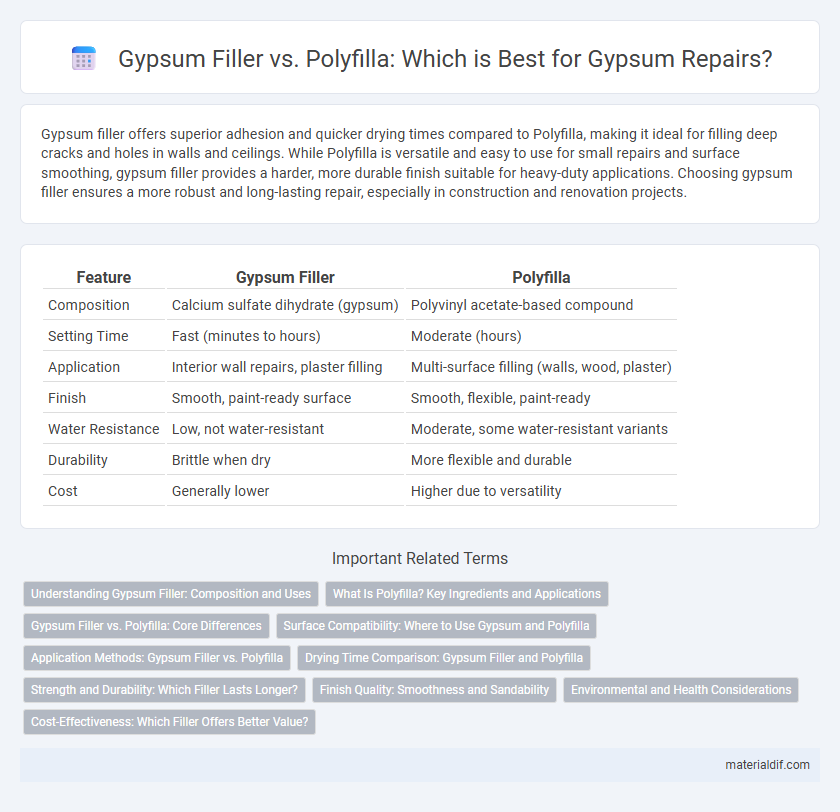Gypsum filler offers superior adhesion and quicker drying times compared to Polyfilla, making it ideal for filling deep cracks and holes in walls and ceilings. While Polyfilla is versatile and easy to use for small repairs and surface smoothing, gypsum filler provides a harder, more durable finish suitable for heavy-duty applications. Choosing gypsum filler ensures a more robust and long-lasting repair, especially in construction and renovation projects.
Table of Comparison
| Feature | Gypsum Filler | Polyfilla |
|---|---|---|
| Composition | Calcium sulfate dihydrate (gypsum) | Polyvinyl acetate-based compound |
| Setting Time | Fast (minutes to hours) | Moderate (hours) |
| Application | Interior wall repairs, plaster filling | Multi-surface filling (walls, wood, plaster) |
| Finish | Smooth, paint-ready surface | Smooth, flexible, paint-ready |
| Water Resistance | Low, not water-resistant | Moderate, some water-resistant variants |
| Durability | Brittle when dry | More flexible and durable |
| Cost | Generally lower | Higher due to versatility |
Understanding Gypsum Filler: Composition and Uses
Gypsum filler primarily consists of calcium sulfate dihydrate, making it a versatile additive in construction and repairs due to its excellent binding and drying properties. It is widely used for filling cracks, smoothing surfaces, and as a base layer in plasterwork and drywall installation. Unlike Polyfilla, which contains synthetic polymers for enhanced flexibility and adhesion, gypsum filler offers superior hardness and quick setting for structural repairs and interior finishing.
What Is Polyfilla? Key Ingredients and Applications
Polyfilla is a versatile filler primarily composed of gypsum, limestone, and binders, designed for repairing cracks, holes, and imperfections in walls and ceilings. Its key ingredients provide excellent adhesion, easy sanding, and quick drying properties, making it suitable for both interior and exterior surfaces. Common applications include patching plaster, filling gaps in drywall, and smoothing uneven surfaces before painting or wallpapering.
Gypsum Filler vs. Polyfilla: Core Differences
Gypsum filler is a mineral-based material primarily composed of calcium sulfate dihydrate, commonly used for interior wall repairs due to its quick drying time and smooth finish. Polyfilla, a synthetic filler containing polyethylene and other polymers, offers greater flexibility and adhesion, making it ideal for a wider range of surfaces including wood and plaster. The core differences lie in gypsum filler's faster setting and eco-friendly composition versus Polyfilla's versatility and superior crack resistance in diverse applications.
Surface Compatibility: Where to Use Gypsum and Polyfilla
Gypsum filler is ideal for interior surfaces such as drywall, plaster, and ceiling repairs due to its excellent adhesion and smooth finish. Polyfilla offers greater versatility, working effectively on a variety of substrates including wood, concrete, brick, and metal. Choose gypsum for high-quality finishes on gypsum-based surfaces, while Polyfilla is suited for multi-surface repairs requiring flexibility and durability.
Application Methods: Gypsum Filler vs. Polyfilla
Gypsum filler is typically applied using a trowel or spatula for filling large gaps and cracks in walls, offering a smooth finish once dried and sanded. Polyfilla, a ready-mixed compound, is spread with a putty knife, ideal for smaller repairs, and dries faster with less shrinkage. Both materials require surface preparation, but gypsum filler demands mixing before application while Polyfilla is used straight from the container.
Drying Time Comparison: Gypsum Filler and Polyfilla
Gypsum filler typically dries faster than Polyfilla, with drying times ranging from 30 minutes to 2 hours depending on thickness, while Polyfilla may require 4 to 24 hours to fully cure. The quicker drying time of gypsum filler makes it suitable for rapid repairs and multiple coats in a shorter timeframe. Moisture content and room temperature significantly impact the drying efficiency of both fillers, but gypsum's mineral base generally accelerates water evaporation compared to the synthetic components of Polyfilla.
Strength and Durability: Which Filler Lasts Longer?
Gypsum filler offers superior strength and durability due to its crystalline structure, making it ideal for long-lasting repairs in plaster and drywall applications. Polyfilla, while versatile and easy to use, tends to be less durable over time, especially in high-impact or moisture-prone areas. For projects requiring maximum longevity and resilience, gypsum filler is generally the preferred choice.
Finish Quality: Smoothness and Sandability
Gypsum filler provides a naturally smooth finish due to its fine particle composition, allowing for easy sanding and seamless blending with walls or ceilings. Polyfilla, while versatile, often requires additional sanding to achieve the same level of smoothness, which can prolong the finishing process. The gypsum-based filler's superior sandability results in a refined surface ideal for high-quality decorative finishes and paint applications.
Environmental and Health Considerations
Gypsum filler is a naturally occurring mineral known for its low toxicity and biodegradability, making it a more environmentally friendly option compared to Polyfilla, which often contains synthetic binders and additives that can release volatile organic compounds (VOCs). The dust from gypsum filler is less harmful to respiratory health than the chemical fumes found in some Polyfilla products, which may cause irritation or allergic reactions. Choosing gypsum-based fillers supports sustainable building practices by reducing indoor air pollution and minimizing environmental impact during disposal.
Cost-Effectiveness: Which Filler Offers Better Value?
Gypsum filler typically offers better cost-effectiveness compared to Polyfilla due to its lower price per unit and efficient coverage, making it ideal for large-scale drywall repairs and construction projects. Polyfilla, while slightly more expensive, provides superior adhesion and flexibility suited for smaller, detailed patchwork and interior decorative finishes. Evaluating project size and finish quality helps determine which filler provides the best value.
Gypsum filler vs Polyfilla Infographic

 materialdif.com
materialdif.com